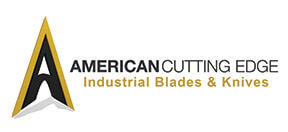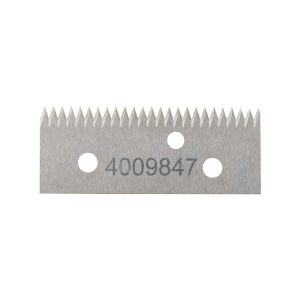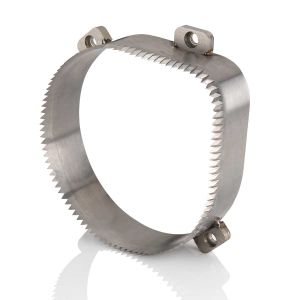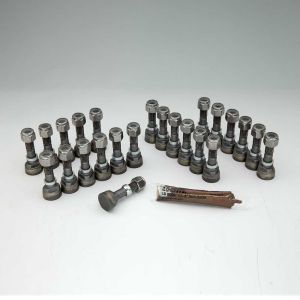The Benefits of Warehouse & Purchase Agreements

As an industrial manufacturer, you have a lot of steps in your production process. You might not give much thought to the impact replacement knives, blades, wear parts, and hardware have on your operation. The reality is that balancing the amount of these components to keep on-hand for your cutting operation is a significant challenge. Regardless of the industry, having the right amount of replacement part inventory on-hand can have a significant impact on the business. Working with the right supplier not only helps organizations manage the financial aspects of extra knives, blades, and parts but also helps keep production running in the event of a major knife failure.
Let's start with the definition of a warehouse agreement. Also known as inventory management programs, these agreements come in different forms, which we will cover later in this blog. The basic definition of a warehouse agreement is the contractual arrangement for an outside company to handle the shipping, receiving, and storage of goods of another organization.
Too Much Inventory or Not Enough?
The word inventory brings to mind a finished product that is sold to a customer. However, businesses that don't create an end product with their manufacturing process also keep inventory on-hand in the form of replacement parts for the machinery used in their operation. One example is size reduction facilities that shred plastic parts and waste into a state that can be used for making products from recycled plastic.
Inventory of any kind is reminder of the cost of money but it's a necessary part of doing business but the cost goes much deeper than cash. Finding the optimal inventory level is no easy task. It's a delicate balancing act of having an adequate supply of spare parts ready for the routine replacement of knives, blades, and hardware. In addition, manufacturers should keep spare above and beyond routine maintenance in the event of a machine failure.
We've found in over 60 years of industrial knife and blade manufacturing that there are times when knives are used well beyond their useful life. When this happens, it increases the risk for catastrophic failure, safety hazards, and interruptions in production due to downtime for extended maintenance and repair.
Missing Something?
When you think about inventory shrinkage, you tend to think of consumer or retail stock walking out of the warehouse in the form of theft. The definition of shrinkage is the loss of inventory that can be attributed to factors such as employee theft, shoplifting, administrative error, vendor fraud, damage, and cashier error. Shrinkage is the difference between recorded inventory on a company's balance sheet and its actual inventory and it costs your organization money.
We've seen instances of customers whose spare knives are taken out of inventory by machine operators without recording the reduction of stock. Because the spare parts were used up quickly when it was in stock, people would take a few spares for their toolboxes so they had them when they were needed. It was a time-consuming hassle to place an internal inventory requisition request for the part. Having the part on-hand saved time and kept production running, says Lynn Harville, ACE Plastics Recycling Product Manager. The end result was tens of thousands of dollars in missing stock. Had the customer worked with us to help manage their inventory flow, the risk of shrinkage would have been mitigated via just-in-time ordering, Harville continues.
Types of Warehouse Agreements
The most common warehouse agreement we see at American Cutting Edge is the blanket purchase order.
A blanket purchase order is also referred to as a standing purchase order and is an ongoing agreement between a vendor and a customer to deliver items at an agreed upon price over a long period of time. It offers stability to the vendor while granting purchase power to the buyer. Benefits include:
- Reduce costs via quantity discounts The commitment to purchase a large quantity of product over the course of a year allows the vendor to order enough product to secure a price break, which is passed along to the customer.
- Mitigate risk of price increases Because the buyer is able commit to enough product and buy ahead, cost increases that can come up through the course of the year for a number of reasons can be avoided.
- Improve efficiency Issuing purchase orders on a continuing basis through the course of a year is time consuming and inefficient. Having one purchase order that can cover the entire year streamlines operations for both the buyer and the seller. In addition, this eliminates the need for the buyer to continue to look for less expensive and more efficient suppliers.
- Facilitates lean operations Properly negotiated blanket agreements allow the buyer to keep stock at their supplier's facility because they can be confident knowing that their supplier will send what is needed as the contract outlines.
Blanket purchase orders can be structured in different ways depending on the needs of the customer.
- Order as needed In the case of ordering as needed against a blank purchase order, the customer will contact the vendor when they need a release of the items they've agreed to purchase over the course of the contract. The order volume may vary from request to request. This is a perfect solution when customers aren't sure how what volume they'll be cutting knives, blades, and wear par over the course of time.
- Automatic Shipments When customers know the exact number of replacement industrial knives, blades, or wear parts they will need, automatic shipments are the way to go. There's no need for a phone call or communication to release the stock. Releases are set for whatever frequency the customer requires and they are sent as scheduled.
Using Warehouse Agreements to Guarantee Uptime Not Price
While the use of warehouse agreements is a great way to reduce costs and increase operational efficiencies, the biggest and best use of these types of arrangements is to supply what customers need to keep production going.
According to Lynn Harville, it's a good rule of thumb for cutting operations to have a minimum of three sets of blades at any time to avoid losing the flow of production. For closed-loop recycling operations, it's critical to have one replacement knife on the shelf, one on the machine, and one spare getting sharpened. Any fewer and you're opening yourself up to a risk of unplanned downtime, says Harville. These knives work hard and can fail if not properly maintained. We've had customers that have not planned ahead only to find that their machine knife failed due to overuse, the replacement was getting sharpened, and there was nothing available to put on the machine, he continues.
Warehouse Investment
Another point to consider when looking to a vendor partner for warehouse agreements and fulfillment is the investment in warehouse and inventory technology being made by the partner. At American Cutting Edge, we have invested in custom racking that will support the heavy weight of industrial machine knives. We're constantly working to create a more efficient warehouse and employ the use of technologies to improve accuracy in inventory management and shipping.
In addition, we have the right equipment to safely handle these heavy, sharp knives. As we've grown our operation over the years, we've constantly improved the flow of the warehouse and have invested not only in equipment, docks, and technology but also built a solid crew of warehouse professionals who understand our products, our industry, and the needs of our customers.
Contact us today to learn how American Cutting Edge can help you streamline your ordering process through blanket orders and warehouse agreements.




